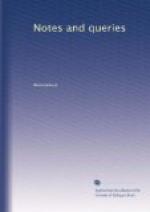HENRY E.
Etymology of Apricot (Vol. ii., p. 420.).—I cannot agree in the opinion expressed by your correspondent E.C.H., that this word is derived from the Latin praecox, signifying “early-ripening,”—that the words [Greek: prokokkia] and [Greek: prekokkia] are {76} Graecised Latin,—and that the Arabs themselves, adopting the word with a slight variation, made it al-bercoy.
The fact of the fruit itself being of Asiatic origin, renders it in the highest degree improbable that the Orientals would borrow a name for it from the Latin.
My own opinion is, that the reverse is the case—that the Latin is merely a corruption of the Arabic; and that the Latins, in adopting the word, naturally gave it the slight alteration which rendered the Arabic word, to them unmeaning, appropriately significant of the nature of the fruit.
I find that in various languages the word strolls thus in the Latin of the middle age, avercoccius—in the modern Greek, [Greek: berykokkion]—in the Italian, albercocco, albicocca—in the Spanish, albaricoque—and all these various words, undeducible from the Latin praecox, are readily derivable from the Arabic word, the prefix al, which is merely the article, being in some cases dropped, and in others retained.
I may add, as a curious fact, that, in the south of Italy, of which I am a native, the common people call the apricot verricocca, and the peach precucco, although the former ripen earlier than the latter.
A.P. DI PIO, Italo-Graecos.
Carlisle.
"Plurima gemma latet caeca tellure sepulta" (Vol. ii., p.133.).—In the course of my reading, some time back, I met with a passage which was given as quotation from Bishop Hall. I transcribe it, as it appears to me to approach nearer to the above hexameter than even Gray’s lines:
“There is many a rich
stone laid up, in the bowels of the earth; many a
fair pearl in the bosom of
the sea, that never was seen, nor ever shall
be.”
Time when Herodotus wrote (Vol. ii., p. 405.).—The passage in Herodotus which shows that he was still employed on his history when he was seventy-five, is in his first book. But A.W.H. thinks, that, as it is a general introduction, showing why he mentioned all places, small or great, it must have been written at the beginning. I should infer the contrary; that he would give an account why he had done so after he had done it, and not while it rested merely in intention.
But perhaps it may be said, that [Greek: en] is in the former part of the sentence, and therefore might have been repeated in the latter part, which is the converse of it, though it might not be exactly the proper tense.
However, F. Clinton puts down his birth B.C. 484; 452 or 456 as the years in which he read his history at the Olympic Games; and 408 as a year in which he was still adding to it.




